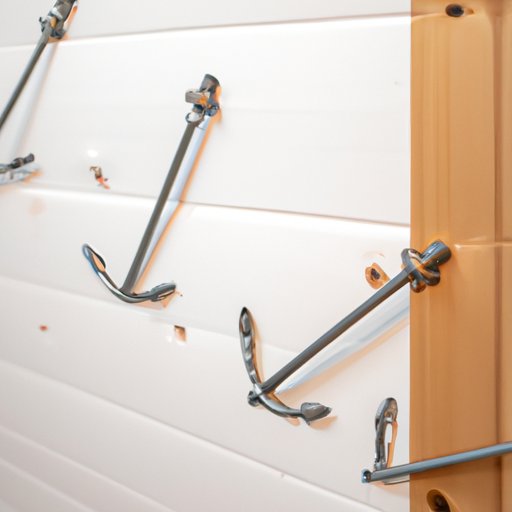Introduction
Have you ever tried to hang a picture or a shelf on drywall, only to see it crumble and fall apart? This is where drywall anchors come in handy. These simple devices allow you to firmly attach anything you want to your walls without fear of damaging them. In this guide, we’ll explore the different types of anchors, how to use them, and even some eco-friendly alternatives.
Different Types of Anchors
Before we dive into how to use drywall anchors, it’s important to understand the different types of anchors available. The most common types are plastic expansion anchors, threaded anchors, and toggle bolts.
Plastic Expansion Anchors
Plastic expansion anchors are designed for lightweight items such as curtains, towel racks, and small picture frames. These anchors work by expanding within the wall as you screw in the bolt, creating a tight hold against the drywall.
Threaded Anchors
Threaded anchors, also known as molly bolts, are sturdier than plastic expansion anchors and can hold more weight. They consist of a metal sleeve that expands behind the drywall, creating a secure anchor point. Threaded anchors are ideal for medium-weight objects such as mirrors, shelves, and small TVs.
Toggle Bolts
Toggle bolts are the strongest type of drywall anchor and can hold up to 150 pounds, making them ideal for larger items such as heavy shelves, ceiling fans, and TVs. They consist of two parts: a toggle and a bolt. The toggle holds the bolt against the back of the drywall, creating a strong anchor point.
Tip: It’s important to choose the right type of anchor based on the weight and material of the item you want to hang. Check the packaging to see the weight limit for each type of anchor.
Step-by-Step Guide
Now that you know about the different types of anchors, let’s walk through the steps of using them to hang your favorite items.
What You’ll Need:
- Drywall anchors
- Drill
- Screwdriver
- Pencil
- Tape measure
- Level
Step 1: Mark where you want to hang your item
Using a pencil, mark the spot where you want to hang your item. Use a tape measure and level to ensure it’s straight and centered.
Step 2: Choose the right anchor
Refer to the packaging for the weight limit of each type of anchor and choose the appropriate one for your item.
Step 3: Drill a hole
Using a drill, make a hole where you marked your spot. Make sure the hole is the same size as the anchor you’re using.
Step 4: Insert the anchor
Insert the anchor into the hole and tap it gently with a hammer until it’s flush with the wall.
Step 5: Screw in the bolt
Screw in the bolt into the anchor until it’s snug against the wall.
Step 6: Hang your item
Hang your item on the bolt and tighten it with a screwdriver until it’s secure.
Tip: Make sure the anchor is flush with the wall and the bolt is inserted straight to ensure a tight fit.
Tips for Hanging Different Items
Rather than guessing which anchor to use for different items, it’s helpful to group them by weight or material. Here are some specific tips for hanging each category of item:
Lightweight Items (up to 25 pounds)
-Use plastic expansion anchors
-Hang curtains, towel racks, and small picture frames
-Make sure the package specifies the anchor can hold the weight of your item.
Medium-Weight Items (up to 50 pounds)
-Use threaded anchors or molly bolts
-Hang mirrors, shelves, and small TVs.
-Make sure the package specifies the anchor can hold the weight of your item.
Heavy Items (up to 150 pounds)
-Use toggle bolts
-Hang large shelves, ceiling fans, and TVs.
-Make sure the package specifies the anchor can hold the weight of your item.
Creative Uses
Drywall anchors aren’t just useful for hanging typical household items. Here are some unexpected uses:
Hanging Plants
Attach hooks to your wall and use plastic expansion anchors to hang lightweight planters.
Tool Organization
Use threaded anchors and hooks to hang tools and keep them organized in your garage or workspace.
Decorative Wall Art
Use drywall anchors to create a pattern or design on your wall with various sizes and shapes of picture frames.
Eco-Friendly Options
If you’re looking for an eco-friendly solution, reusable anchors or biodegradable options are available. Here are some recommendations:
Reusable Anchors
Instead of plastic expansion anchors, consider using reusable anchors made of metal or other durable materials. These anchors can be used multiple times, unlike plastic anchors which should be tossed after use. Look for brands like Toggler or WingIts.
Biodegradable Anchors
If you’re concerned about the environmental impact of your anchors, consider using biodegradable options like those made from bamboo or cornstarch. These anchors will naturally break down over time, reducing waste. Look for brands like Sparllo.
Troubleshooting
Even with the right anchor and a steady hand, sometimes things go wrong. Here are some common issues and how to fix them:
The anchor won’t hold
-Try a heavier-duty anchor
-Make sure the hole is the correct size
-Check that the anchor is inserted all the way into the hole
The anchor won’t fit in the hole
-Make sure the anchor is the correct size
-Drill a larger hole
-Don’t force the anchor into the hole
The anchor is stuck in the wall
-Use pliers to gently pull out the anchor
-Try tapping the anchor with a hammer to loosen it
-Use a drill to carefully remove the anchor
Conclusion
By following these simple steps and tips, you can confidently hang anything on your walls without fear of damaging them. Don’t be afraid to get creative with your anchors or try out eco-friendly options. Have fun hanging!
Call-to-action: Share your favorite uses for drywall anchors in the comments below and inspire others to get creative with their wall decor.
